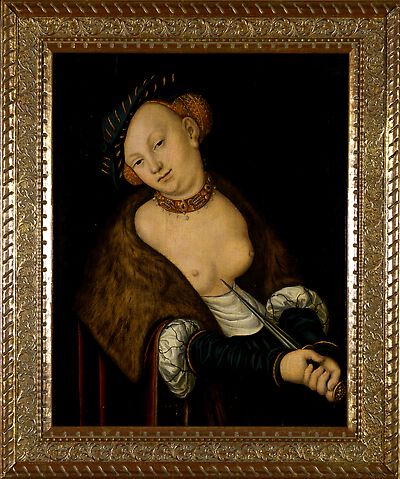The painting depicts Lucretia as a half-length figure in contemporary dress.
Her head is inclined slightly to the left and her gaze is directed at the viewer. At the bottom right edge of the painting both hands grasp the long dagger, which she points at her breast.
Lucretia wears a dark,
The painting depicts Lucretia as a half-length figure in contemporary dress.
Her head is inclined slightly to the left and her gaze is directed at the viewer. At the bottom right edge of the painting both hands grasp the long dagger, which she points at her breast.
Lucretia wears a dark, contemporary robe and a white undergarment with puffed sleeves, which is open revealing her bare chest. A fur-trimmed, red gown covers her shoulders. Her hair is concealed under an embroidered bonnet over which she wears a hat. She wears a necklace decorated with pearls and precious stones as jewelry.
The background is dark.
According to the legend Lucretia lived in the 6th century BC and was the beautiful and virtuous wife of the roman Collatinus. The roman King's son - Sextus Tarquinius fell in love with her. During a stay in her house Sextus threatened to kill her and shame her honour if she did not surrender to him. After the rape Lucretia had her father and husband vow vengeance and then she stabbed herself. The event led to an uprising in which the royal family was overthrown and the Roman Empire became a Republic.
Depictions of Lucretia who was seen as the epitomy of female virtue, chastity, fidelity and honour enjoyed great popularity, particularly in the 16th century.
[Literature: Bierende 2002, Follak 2002, Livius 1909]

